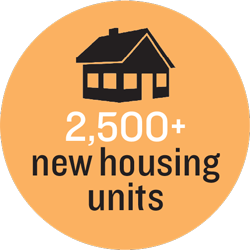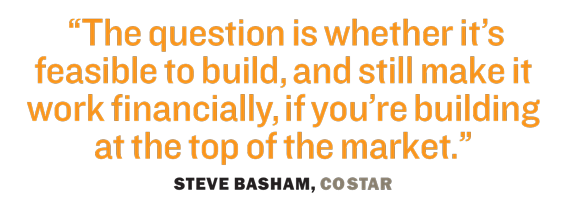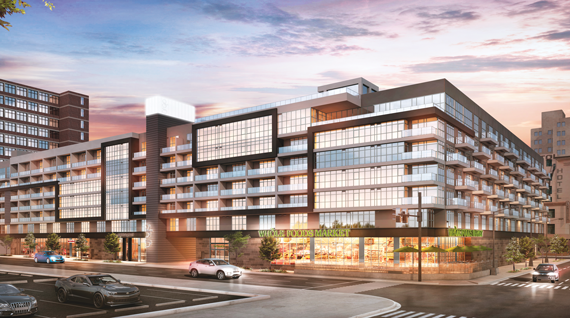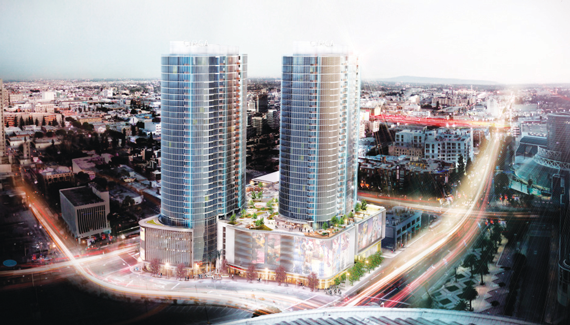Real estate investors have increasingly poured more and more money into Downtown Los Angeles over the past two to three years, building skyscrapers, revamping retail spaces and redeveloping older industrial structures. This may be the area’s most active period since the 1990s, when developers first began erecting gleaming skyscrapers in an area once dominated by drab parking garages, low-rise buildings and high crime rates.
But at this late stage of the building boom, some market pros are wondering whether there’s enough interest from potential residents, retailers and companies in all the new space coming on the market in DTLA, as the neighborhood has become known.
“The question is whether it’s feasible to build and still make it work financially, if you’re building at the top of the market,” said Steve Basham, a senior market analyst at research firm CoStar.
Given the rise in vacancy rates and the slower growth of asking rents, Basham speculated that some developers might decide to postpone projects. “If developers approved their new developments pro forma based off of 2014 or even 2015 rental levels, when their projects deliver in 2018, they’ll probably find themselves in a different situation,” he said.
More than 2,500 new housing units — primarily rental apartments — were delivered in the 12 months ending June 2016, with another 5,000 or so under construction, according to CoStar data. And, sure enough, vacancy levels for the residential units are beginning to rise.

The residential vacancy rate in DTLA was a low 4.1 percent in 2013, but rose to 6.7 percent in 2014 and 6.9 percent in 2015. CoStar Market Analytics projects that it will rise above 7 percent this year. In a bid to attract tenants, downtown developers have begun offering concessions on new apartment leases, a practice unheard of elsewhere in the region. George Crawford, a commercial broker with Charles Dunn Company, said the building boom reminded him of the end of the last cycle, in 2006 and 2007. “You see all these homes going up,” he said, “and it makes you think, ‘where are all these people coming from?’”
A 24-hour neighborhood
Yet new residents keep moving into DTLA. The neighborhood’s population grew by 9 percent from 2010 to 2015, compared with a 4 percent growth rate for the Greater Los Angeles area. The median annual income of the neighborhood’s residents stands at $98,000, according to a survey by the Downtown Center Business Improvement District.
Some market pros attribute the influx to the tendency of high-earning millennials to gravitate toward urban centers. The recent extension of the metro’s Purple Line also allows residents to commute more easily between Downtown and the West Side.
Many developers who got in on the ground floor of the recent boom have reaped the rewards. Projects such as the first phase of One Santa Fe, which has added 438 units to the market so far, and the 290-unit 8th + Hope, both delivered in 2014, are now fully leased up. Even some of the apartment buildings that opened in 2015, while a little slower on the uptake, are nearing full occupancy. DTLA’s average rents clock in at roughly $2,200 per unit, or about 20 percent higher than the average for the region, according to CoStar.
But as more inventory hits the market, would-be residents find themselves spoiled for choice. Some of the area’s largest and most high-profile new residential projects include Eighth & Grand, a 700-unit high- rise that is slated to open in October 2016; Circa, a 648-unit residential tower near the Staples Center, planned for completion in 2017; and the first phase of the massive Metropolis project, which will add 308 condos to the market later in 2016.
 Landlord concessions at some of these high-flying projects may indicate the early stages of a slowdown. Eighth & Grand was offering up to six weeks free rent to new tenants at the end of the second quarter of 2016.
Landlord concessions at some of these high-flying projects may indicate the early stages of a slowdown. Eighth & Grand was offering up to six weeks free rent to new tenants at the end of the second quarter of 2016.
“The vacancy rate in and of itself isn’t a reason for panic,” Basham said. “It was pretty much unavoidable with so many new units hitting at the same time. But you’re probably not going to see the aggressive rents that you saw early in the cycle.”
If the goal of developers is to create an urban “live/work/play” environment, the missing link may be retail, which has been showing signs of weakness. For example, the majority of the retail portion of The Bloc, an ongoing mixed-use project with more than 150,000 square feet of retail space, hasn’t opened six months after it was scheduled to debut. Speculation is rife that some of the tenants showing initial interest in the complex ultimately did not sign on.
Brokers say that with so many retail spaces being created at the street level of new residential towers, a question mark hangs over whether there will be enough demand. Another complication is the rising homeless population, which has led to persistent concerns about safety in the area. “Downtown is still in the early stages of its renaissance, and it remains to be seen what’s going to happen with these retail spaces,” Crawford said. “Some of these concepts are unproven.”
Foreign investors
Real estate investment in DTLA has been buoyed by a handful of big deals by major institutions and foreign players willing to bet big on the area’s long-term renaissance.

Eighth & Grand, a 700-unit condominium, will debut in the fall of 2016.
Wilshire Grand Center — a 1.6 million square-foot office, hotel and retail tower being developed by Korean Air — is slated for completion in 2017, when it will become the tallest structure west of the Mississippi. It will assume that title from the current holder, the nearby U.S. Bank tower. Yet the Wilshire Grand isn’t even the largest project under construction in DTLA. That would be the 2.1 million square-foot Metropolis Los Angeles being developed by Greenland Group, China’s largest real estate developer, which is state-owned.
Market experts say that many local real estate players are being priced out of the market, with the exception of some California-based real estate investment trusts and the occasional large private developer such as Jamison.
The prices for investment sales might still look like a bargain relative to comparable buildings in New York or San Francisco, but the spread is tightening. Experts say that some DTLA buildings that would have fetched $100 to $150 a square foot a few years ago are now selling for up to $440 or $450 a square foot.
The cost of increasingly elusive building lots is being pushed higher by the influx of international capital, said Alexa Arena, executive general manager of West Coast development at Lend Lease, which opened up shop in L.A. in early 2016 with a view toward investing here. “This is happening to an extent that it’s becoming more difficult to delineate the true value — the intrinsic value — of land,” she said. Redevelopment
As the market for developable land parcels tightens, the redevelopment of existing structures becomes a compelling option. Indeed, almost 10 percent of the area’s total inventory changed hands at least once within the 12 months ending in June 2016.
“You’ve got these historic, beautiful buildings from the early 1900s that you only see in other top tier towns, and they’ve been underutilized,” said Gibran Begum, a managing director at Newmark Grubb Knight Frank. “There’s been a large rush to come in and repurpose them.”

Those repurposed buildings have been a draw to creative tenants, many of which are looking for more inspirational spaces than typical glass towers. Warner Music Group is just one of the major creative tenants reportedly eying DTLA, and the company is rumored to be relocating from Burbank to the Ford Factory in the area’s Arts District. Landlord Shorenstein Properties bought the old Ford motor plant in 2014 and is turning it into a mixed-use complex. A Shorenstein spokesperson told TRD that they were not commenting on the rumors about Warner.
Among the adaptive reuse projects underway is Simon Baron Development’s bid to transform the historic Hotel Cecil, at 640 South Main Street, into a 301-unit micro-apartment complex. This 600-room hotel sits only a few blocks from Skid Row.
Canadian developer Onni Group plans to turn a landmark Art Deco building at 202 West 1st Street into a residential and retail development. The Vancouver-based firm also owns the historic Western Pacific Building at 1031 South Broadway.
This frenzy of activity has only confirmed for some real estate investors that the DTLA market is the place to be, said Newmark’s Begum. “It’s been a huge beacon for capital.”
